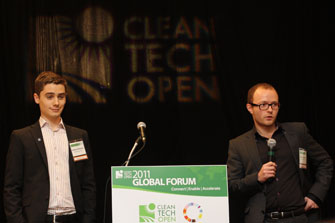Prizes Finance Students’ Solar Company
Hjalmar Nilsonne is making good on an entrepreneurial dream — and winning prizes — with the newly established company Black Silicon Solar. All while he’s still a student at KTH.

When Hjalmar Nilsonne heard about Rasmus Davidsen’s degree project a year ago at the Technical University of Denmark, DTU, he immediately recognised the commercial potential. Nilssone and Davidsen are now partners in the start-up company Black Silicon Solar.
“We use nanostructures to make solar cells that absorb more light, and at the same time are cheaper to manufacture”, explains Nilssone, a KTH student of energy technology.
It didn’t take long for the students’ partnership to find success. In early 2011, Black Silicon Solar took first prize in London Business School’s CleanTech Challenge.
By June it was time for the Danish Venture Cup startup competition, where Black Silicon Solar again won first prize.
In November the company was competing again, this time in the U.S. Cleantech Open in Silicon Valley, where 25 countries sent their sharpest environmental technology companies. Black Silicon claimed a spot among the six best in the world.
Along with considerable prestige, Black Silicon’s winning streak brought checks totalling some $55,000 — money that the founders have ploughed right back into building the business.
“It’s a great start for Black Silicon Solar,” Nilsonne says. “Now we’re building a more robust prototype to really be able to convince investors. We’re aiming for a first round of financing in the second quarter of 2012.”
Nilsonne has six months left of his studies before it’s time to start on his own degree project, which he plans to focus on Black Silicon Solar (known as exjobb in Swedish, the degree project at KTH generally involves 20 weeks of full-time research and analysis on a problem provided by an instructor or an external company).

“The most important thing to think about is how your work can be useful to others — that’s a responsibility we have as engineers. I want to show other students that it’s possible to start and run a business based on research in green technology. That’s what gets me excited”, Nilssone says.
“Thousands of degree projects never get used and they’re just forgotten. If we hadn’t made an impulsive decision to start a company around our solar-cell concept, Black Silicon Solar would never have been in a position to make a contribution in the future.”
Nilsonne hopes to inspire other students to come up with new product ideas around green innovation.
“My best advice to prospective entrepreneurs is that you should look for something you don’t have yourself. If you think you have a cool innovation, then you should look for a partner who’s a great economic and strategic thinker.
“Engineers are used to being smart, and they think they don’t need any help with the stuff that’s ‘easier’ than their area of expertise. But that’s completely wrong. To succeed at something, whatever it is, you have to assemble a diverse team and let people take on specific tasks.”
For more information: Hjalmar Nilsonne, +46-704-15 63 62; hjalmar.nilsonne@gmail.com
London Business School CleanTech Challenge
Katarina Ahlfort